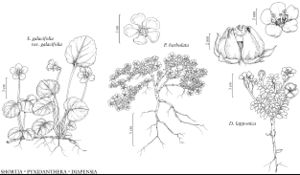Pyxidanthera barbulata
Fl. Bor.-Amer. 1: 152, plate 17. 1803 ,.
Stems commonly elongate and creeping, sometimes compact and short-creeping or not creeping, glabrous or sparsely hairy; internodes usually 1+ mm. Leaf-blades narrowly oblanceolate to lanceolate, 3.5–7 (–10) mm, herbaceous, those of fertile shoots ciliate along proximal margins, adaxial surface usually white-pilose on proximal 1/5–1/3. Flowers: calyx pinkish; corolla lobes 3–5 mm. 2n = 12.
Phenology: Flowering Mar–May.
Habitat: Pine savannas and barrens (commonly with Pinus rigida, sometimes with Quercus marilandica and Q. ilicifolia), pine flatwoods, pocosin margins, streamhead ecotones, edges of sandhill seepage bogs (with Pinus serotina and P. palustris, usually with Aristida stricta and Vaccinium crassifolium), depressions, primarily mesic to hydric sites, wet sands and peaty sands, sometimes submesic sands, usually with permanently or seasonally high water table, often with Sphagnum
Elevation: 10-200 m
Distribution

N.J., N.Y., N.C., S.C., Va.
Discussion
There are no current or historical records of Pyxidanthera barbulata from Delaware or Maryland, where habitats exist that seem comparable to those where the species occurs north and south.
Pyxidanthera barbulata is in the Center for Plant Conservation’s National Collection of Endangered Plants.
Selected References
None.
